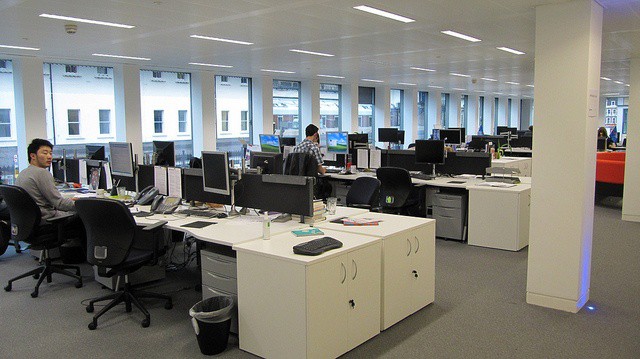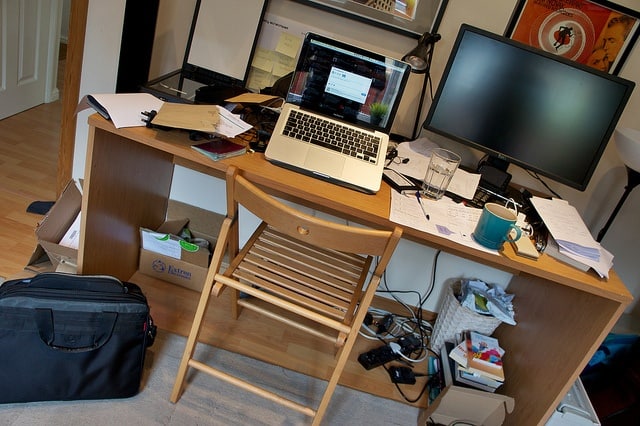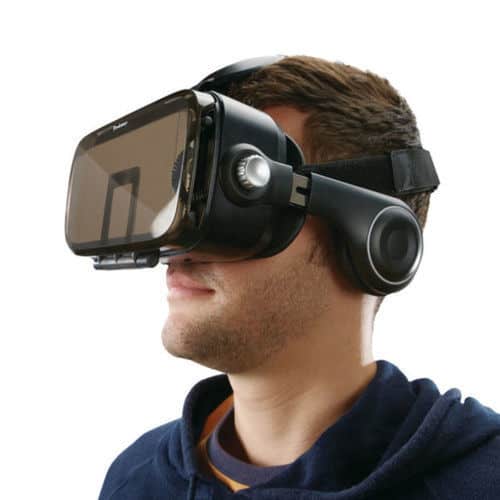The way we work is changing more rapidly than ever before. People are more frequently working from home or using innovative spaces to get the job done. There are co-working spaces, cafes, and office buildings that allow for you to have one very small office space. Of course there are still more traditional offices, too. Each of these spaces are suited for different types of workers. Herein lies the question: what office type is right for your small business?
Traditional Office Type
This one needs far less introduction than some of the other office types on this list. The traditional brick and mortar office has been around as long as people have run a business. It’s a carved out workspace that usually will consist of cubicles, a communal space for coffee and breaks, and a conference room.

Image via Flickr Creative Commons
Pros
The best part about having a traditional office type is that it is a professional space to present to your clients. That conference room comes in handy, whether pitching a new client or discussing major changes that are upcoming within your organization. A brick and mortar office is the way to go for small business owners who feel that meeting clients is essential to customer service success.
When you have a brick and mortar office, you also have better control of the work environment. You’ll know what each employee has access to regarding tools and technology. It will be easy to see who is on task and who is being a lazy employee. You can see for yourself who is working with a cluttered workspace and whether their productivity is cutting into your bottom line.
You’ll also have a better ability to shape the company culture. The right company culture will create a workplace that employees can feel loyal to. For example. a company culture where each employee feels like a valuable member of the team and genuinely enjoys the company of their colleagues is less likely to want to look for a position elsewhere.
The traditional brick and mortar business that has private offices and/or cubicles is a great marriage of collaboration and privacy. Employees can touch base in person with their colleagues frequently, yet still feel a sense of ownership within their separate space.
A receptionist at the front of the office space, guiding visitors to their intended destination and giving them additional information and forms as needed. A receptionist is important in a large office setting.
Cons
Well, for one, it’s expensive. A traditional brick and mortar office type will cut in to your business’ bottom line. There’s often a hefty monthly rent. You’ll be responsible for buying furniture, computers, supplies, coffee and snacks for the team. When it comes to small businesses, you can’t always afford to spend capital haphazardly.
Location can be limiting. You narrow your pool of quality employees with the physical location of your office space. Most people won’t be willing to drive an hour every day in traffic to a new place of employment. Factor in train tickets or subways in certain parts of the country and you have a commute that is expensive in both time and money spent.
Lease commitments are limiting. If your business is new, signing on for a year or two is risky. We’d all like to think that our business endeavors will be fruitful. But what if they’re not? What if you have to close down shop, yet owe money for where the shop once was?
Open-Plan Office Type
An open-plan office is like a traditional brick and mortar office, but missing the cubicles and/or individual rooms for employees. In an open-plan office, everyone shares one communal space and often they share long desks, though individual spaces are clear cut. Each person has their own tools but doesn’t have privacy.

Image via Flickr Creative Commons
Pros
An open plan office type share much of the same pros as the traditional office. It’s professional, you’ll have more control, the company culture is more likely to flourish. But there’s more.
For one, there’s serendipity. ‘What’s that?’ You may ask. Serendipity is the occurrence and development of events by chance in a happy or beneficial way. It’s a lot like luck. There are more chances for serendipity with an open office plan. According to Jack Dorsey, co-founder and CEO of Twitter and founder and CEO of Square, this is an important aspect of the culture of an open-concept office.

Screenshot via ArchDaily
Serendipity and creativity are both crucial in the startup sphere. An open office type encourages creativity because one staff member doesn’t even need to leave their desk to throw out an idea to the team. Team members are always in earshot so there’s less pressure to throw out an idea, still looking at your computer, and see how it sits with those around you. Far less pressure than walking to another person’s office and asking them what you think of an idea.
This ease of brainstorming can only occur in an open office setting, which is an incubator for better internal communication and collaboration.
Some also argue that an open office type increases productivity by making people feel more accountable for their work output. If they feel like the boss can see over their shoulder that they’re fooling around with Facebook instead of writing software code, they’re less likely to want to get distracted.
An open office type is also a money-saving option compared to a traditional office space. An open office plan requires less square footage, less furniture, and is overall a cheaper option.
Cons
There is the same level of commitment and restrictive location as a traditonal office. And though the cost is lower for an open-office concept, it’s still an expensive route compared with others. Just as there are additional pros to the open office vs. traditional brick and mortar, there are additional cons.
First of all, lack of privacy can be an issue.
Though the thought of boss looking over your shoulder may dissuade some employees from self-distraction, many agree that an open office type is one that is plagued with distractions. Just as an employees can throw out there that the team should try out a new social media initiative, they can also encourage their neighbor to watch some viral cat video. When the laughter erupts, the whole office can get distracted.
Research also shows that an open office type increases sick days.

Screenshot via Forbes
Recent studies also have shown a correlation between open office plans and higher levels of stress. Apparently, all of those distractions decrease motivation and encourage work-related stress.
Coworking Office Type
If your team is really small or you’re a one man (or woman) show, a coworking office may be the solution that best suits your needs. Coworking offices are relatively new compared to traditional offices and open-plan offices, so don’t fret if you’ve never heard of one before.

Image via Flickr Creative Commons
Essentially, a coworking space is where workers from many different companies and industries gather. There are generally communal areas and hot desks, or working desks that belong to no one but are open for anyone to use. With the influx of freelancers in what is now known as the “gig economy,” there was a need for working spaces beyond coffee shops and local libraries. Thus, the coworking space was born.
Pros
The greatest aspect of a coworking office type is that there are many opportunities for networking and bringing in more clientelle for your company. If you’re head of a marketing company, for example, and your hot desk of the day is situated next to someone who has startup funding and no marketing expertise on their team, you could have something serendipitous going.
Even when you’re not networking with potential clients at a coworking space, you’re still a part of a community of like-minded (or, atleast, like-working) individuals. Freelancers often feel isolated when they try to work from home successfully, but that doesn’t have to be the case.
Costs are significantly lower with a coworking space membership. Now, a coworking office type isn’t as cheap as heading over to your local library. But you also won’t have to worry about toddler reading day happening when you were planning on getting some work done. WeWork, one of the largest coworking chains in the U.S., for example, is only $45/month for basic membership with access to the WeWork network and credits to book a room or use a hot desk.
Cons
With other people come many distractions. Some coworking spaces are known to have more than coffee available to its’ patrons.
In fact, draft beer is sometimes on the menu. All of that networking and community creation can eventually get in the way of actual work getting done.
There’s also often a higher amount of noise at a coworking space for the same reasons. A noisy atmosphere can be detrimental for a work environment in many ways, including increasing stress and decreasing productivity. But there’s much more, according to Resonics.
Home Office

Image via Flickr Creative Commons
Then, there’s the home office. You know what this looks like. Of course, everyone’s home office setup is different. Many factors can play a role in how well a home office works for each person. Factors include additional responsibilities at home, ability to stay on task, and people who share the home with you during your typical work hours.
Pros
The biggest pro for those who work from home is certainly the flexible scheduling. There are many responsibilities that one has outside of work, and a flexible schedule allows for someone to fit everything in.
Because there is flexible scheduling. you could have a better work-life balance than you would if you’re spending a lot of time commuting back and forth to the office. You could have more time for family and your personal life.
Work is never far away, and that’s a good thing. You’ll be able to give A1 customer service to your clients because you’ll be available to help them at the drop of a hat. Even international clients will get to schedule a meeting at a time that works for them if all you have to do is head from the bedroom to the office.
Cons
Just as a traditional office can narrow your pool of prospective employees, so can work-from-home. You often wont’ be able to host several employees, so instead you’ll have to rely on each individual to have the tools and technology needed in their own home. That, and there are many people who have discovered that working from home isn’t for them. They may get too distracted or they may need a physical bounary in place between work and home life.
Speaking of lack of boundaries, this is certainly the biggest issue with working from home. If you’re always on and available, where is the work-life balance in that?
Then there’s isolation. Working from home has the potential to negatively affect not only your productivity, but also your mental health. Even when your work-life balance isn’t out-of-whack, you could fall victim to staying in your lounge wear and never leaving the house for friends and sunshine. That’s no good on the psyche.
There’s also the issue of having no professional space to host clients. You’ll have to settle for meeting over coffee, lunch or dinner if you want to have an in-person meeting with the people that you service.
Virtual Office
Here’s another one you might not have heard of before: a virtual office. If you’re imagining something like this:

Image via Brookstone
You may want to dial down the imagination a bit. A virtual office is essentially saying that you’re not limited to any of the office spaces as described above. You can work from anywhere! A virtual office goes wherever you and your laptop go, provided you have all of the right software installed.
Pros
Well, we’ve been talking a lot about cost this article, and it’s time for some good news: no rent! No lease agreement! A lot of times all you need to buy while using your virtual office is a cup of coffee prior to signing into the cafe’s WiFi. And you’re likely already going to do that, so low-to-no cost!
There’s so much freedom involved with a virtual office space. You’re not limited to a home office, a coworking space, or a coffee shop. You can work on the beach! In the mountains! In the desert! Wherever your heart desires.
These days people want to live by their values in ways that they haven’t before. One way is through the minimalist movement, having a smaller environmental impact, and accruing less material items. Having a virtual office is as minimal as you can get–you don’t even need to own a desk!
You can still appear professional. No one has to know that you don’t have a physical office. If you want to have the appearance of a more established business, you can always hire a virtual receptionist to go along with your virtual office.
Cons
Well, we’re back at the same issue that you have with a home office: no professional space. So this may not be the best choice for you if that is important to your small business.
Here’s another thing: there are distractions EVERYWHERE! Eventually the humming of a coworker in an open office may not get to you, or it won’t bother you that you need to organize your office. But the constant novelty of working many different places will mean far more distractions than usual.
There’s one issue at hand. There’s often a communication lag when you’re using a virtual office. It’s not as easy as walking down the hall to ask Deborah a question, after all. You may have to wait quite some time to get an answer from your colleague or client. The time doubles if you’ve found your virtual office on the other side of the globe where time changes make a big difference.
Distractions, In Sum
Every office type is going to have one distraction or another. It can be toxic employees at a traditional office, a heavy breather seated next to you at an open office, curiosity over your neighbor’s line of work at a coworking space, or your own laundry at your home office. If you’re a business owner with ADHD, you’ll have to decide which environment is the lesser of evils when it comes to your office space.
Apply this to your small business
What office type will work best for the business that you currently have or are starting? You’ll need to consider many factors when deciding this, not just cost.
Factors to consider include:
- Team size
- Need for professional space to meet clients frequently
- Company culture
- Capital
- Preference
